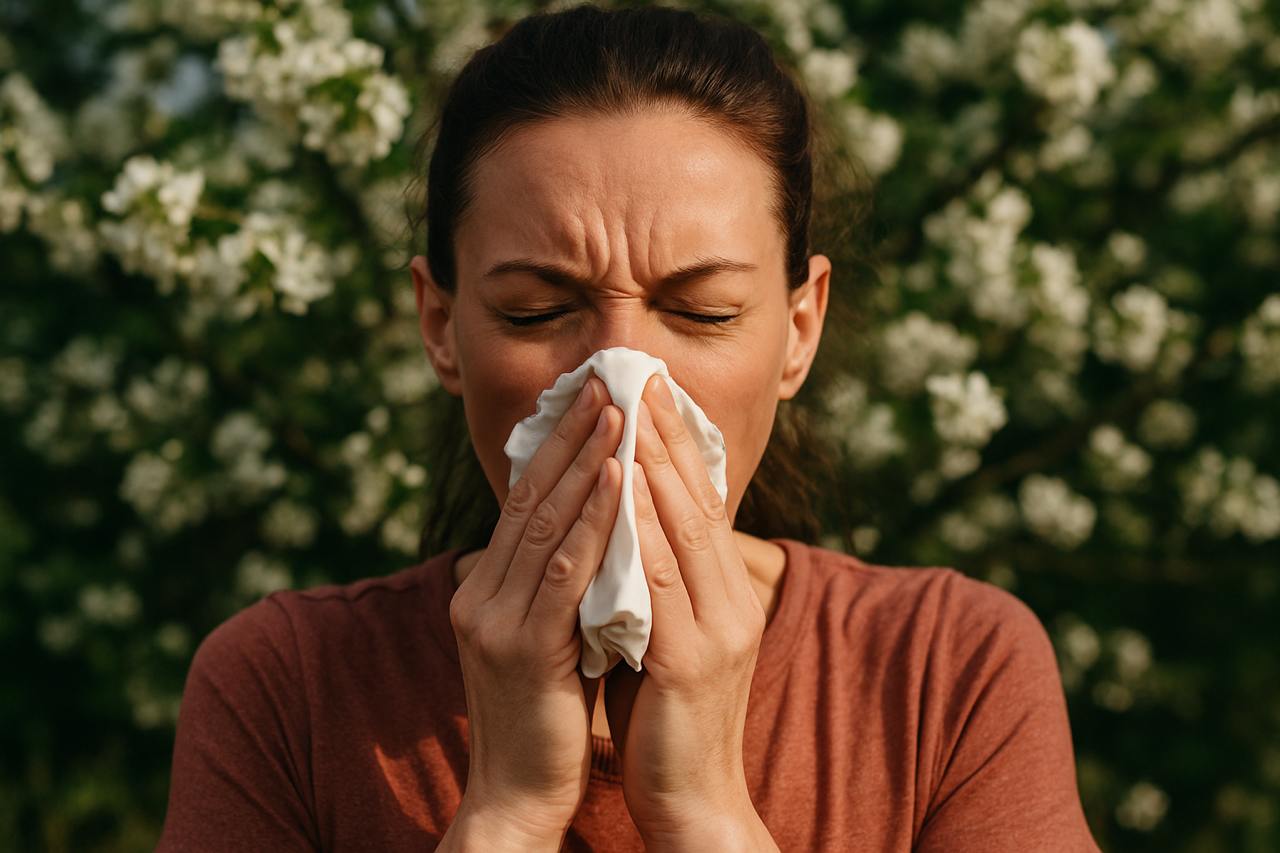
Лікування легкої та сезонної алергії онлайн
Якщо у вас типові симптоми — нежить, свербіж, висип або сльозотеча, ви можете отримати призначення від лікаря без візиту до клініки. Заповніть анкету, і лікар підбере відповідне лікування.
 Підходить при повторюваних симптомах
Підходить при повторюваних симптомах Рішення лікаря — зазвичай протягом кількох годин
Рішення лікаря — зазвичай протягом кількох годин За показаннями — офіційний рецепт, дійсний у вашій країні
За показаннями — офіційний рецепт, дійсний у вашій країні
Як отримати лікування при сезонній алергії
Якщо симптоми з’являються не вперше, допомогу можна отримати без очного візиту до лікаря.

Примітка: Підходить для повторюваних або контрольованих симптомів. Лікар приймає рішення індивідуально. У разі гострих або нетипових проявів буде запропонована консультація.
Швидке рішення при сезонній алергії
Якщо симптоми повторюються — не зволікайте. Отримайте рішення від лікаря без запису та очікування.
Допомога при типових проявах
Нежить, свербіж, висип, сльозотеча — якщо ви вже знайомі з цими симптомами, лікар швидко допоможе.
Працює при сезонній алергії
Алергія на пилок, пил або тварин? Лікар допоможе зменшити симптоми ще до загострення.
Призначення без відеозвʼязку
Все відбувається онлайн — ви описуєте симптоми в анкеті, лікар вивчає інформацію та приймає рішення.
Рецепт за показаннями
Якщо ваш стан не потребує очного огляду — лікар може призначити лікування та видати рецепт.
Врахування вашої країни
Рецепт відповідає вимогам країни, яку ви зазначите. Його можна використати в аптеці.
Прозора оплата без доплат
Оплата стягується лише у разі схвалення. Якщо лікар відмовить або запропонує консультацію — кошти повертаються.
Сезонна алергія: симптоми, тригери та варіанти лікування
Дізнайтесь, як розпізнати симптоми легкої або сезонної алергії та коли варто звернутись за допомогою. Навіть незначні алергічні реакції можуть впливати на самопочуття, особливо в період активного цвітіння.
Що таке алергія та як вона проявляється
Алергія — це надмірна реакція імунної системи на зазвичай нешкідливі речовини: пилок, шерсть тварин, пилових кліщів, плісняву або певні харчові продукти. Ці речовини називають алергенами, і при контакті з ними в організмі запускається запальна відповідь.
Легка алергія зазвичай проявляється як закладеність носа, нежить, часте чхання, свербіж в очах або висип на шкірі. Симптоми можуть з’являтися час від часу або постійно — залежно від сезону чи впливу тригерів.
Найбільш поширені прояви включають сезонний алергічний риніт (поліноз), контактний дерматит та легкі харчові реакції. Вчасне виявлення симптомів допомагає запобігти загостренням та погіршенню якості життя.
Найчастіші типи легкої та сезонної алергії
Весняна алергія, зумовлена пилком дерев, трав або бур’янів, є найрозповсюдженішою формою. Симптоми погіршуються на вулиці та досягають піку в період активного цвітіння.
Контактна алергія може виникати через контакт із шерстю тварин, пилом, миючими засобами, латексом або деякими тканинами. Найчастіше це висип або свербіж, які зникають після усунення подразника.
Інші часті тригери включають укуси комах, окремі продукти харчування або компоненти косметики. Навіть якщо симптоми незначні, важливо не ігнорувати їх, адже алергія має тенденцію до прогресування.
Чому не варто ігнорувати симптоми легкої алергії
Симптоми на кшталт нежитю, свербежу очей або чхання можуть здаватися дрібницею, однак при повторному впливі алергенів реакція може посилюватись. Хронічна алергія підвищує ризик розвитку синуситу, бронхіальної астми або хронічного риніту.
Також алергія впливає на якість сну, концентрацію уваги та рівень енергії. Без лікування вона може спричинити емоційне виснаження або послабити імунітет.
Вчасне звернення до лікаря дозволяє уникнути загострень, підібрати ефективне лікування та полегшити щоденне життя. Особливо важливо це для людей, які щороку стикаються з сезонними проявами.
Як лікар обирає метод лікування алергії
Лікування залежить від виду алергії, віку пацієнта, вираженості симптомів та загального стану здоров’я. Найчастіше призначають антигістамінні препарати, назальні спреї, очні краплі або мазі. У деяких випадках — гормональні засоби місцевої дії.
Лікар враховує тривалість симптомів, частоту загострень, наявність хронічних захворювань та можливі побічні ефекти. При сезонній алергії важливо починати терапію ще до активного періоду цвітіння.
Якщо симптоми повторюються, може бути рекомендоване додаткове обстеження, тестування на алергени або побудова довгострокового плану контролю. Але навіть без тестів можна отримати безпечне та ефективне полегшення симптомів онлайн.
Як відрізнити алергію від застуди
Алергія часто плутається з ГРВІ, оскільки симптоми подібні: чхання, нежить, втома. Проте є чіткі відмінності. Алергія починається раптово, зазвичай без температури та болю в тілі.
Носові виділення при алергії прозорі, чхання часте, часто супроводжується свербежем у носі та очах. Симптоми можуть тривати тижнями і повторюватися щороку в один і той самий час.
При застуді симптоми наростають поступово, є підвищення температури, біль у горлі, кольорові виділення з носа. Хвороба зазвичай минає за кілька днів.
Якщо ваші симптоми з’являються щовесни або тривають довше за типовий вірус — ймовірно, це алергія. У такому випадку варто звернутись до лікаря для підбору лікування.



















Про медицину та здоров'я в Європі
«Статті про систему охорони здоров’я, досвід пацієнтів та інші теми для тих, хто живе в Європі.
Поширені запитання про лікування сезонної та легкої алергії
Дізнайтеся, як працює швидке призначення, які симптоми підходять для такого формату, і коли варто звернутися до лікаря особисто.













